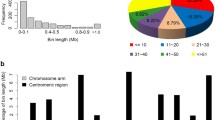Abstract
The recessive fgr gene on chromosome 8 is associated with rice fragrance. It has been reported that this gene is a non-functional badh2 allele and that the functional Badh2 allele encoding putative betaine aldehyde dehydrogenase (BADH2) could render rice non-fragrant. Here we report the discovery of a new badh2 allele and the development of functional markers for the badh2 locus. A total of 24 fragrant and ten non-fragrant rice varieties were studied and sequenced for their Badh2/badh2 loci. Of the 24 fragrant rice varieties, 12 were found to have the known badh2 allele (badh2-E7), which has an 8-bp deletion and three single nucleotide polymorphisms (SNPs) in exon 7; the others had a novel null badh2 allele (badh2-E2), which has a sequence identical to that of the Badh2 allele in exon 7, but with a 7-bp deletion in exon 2. Both null badh2 alleles are responsible for rice fragrance. Based on sequence divergence amongst the functional Badh2 and two null badh2 alleles, we developed functional markers which can be easily used to distinguish non-fragrant from fragrant rice and to differentiate between two kinds of fragrant rice. These functional markers will find their usefulness in breeding for fragrant rice varieties via marker-assisted selection.



Similar content being viewed by others
Abbreviations
- 2AP:
-
2-Acetyl-1-pyrroline
- BADH:
-
Betaine aldehyde dehydrogenase
- QTL:
-
Quantitative trait locus
- SNP:
-
Single nucleotide polymorphism
References
Andersen JR, Luebberstedt T (2003) Functional markers in plants. Trends Plant Sci 8:554–560
Bradbury LMT, Fitzgerald TL, Henry RJ, Jin QS, Waters DLE (2005a) The gene for fragrance in rice. Plant Biotechnol J 3:363–370
Bradbury LMT, Henry RJ, Jin QS, Reinke RF, Waters DLE (2005b) A perfect marker for fragrance genotyping in rice. Mol Breed 16:279–283
Buttery RG, Ling LC, Juliano BO, Turnbaugh JG (1983) Cooked rice aroma and 2-acetyl-1-pyrroline. J Agric Food Chem 31:823–826
Chen YM (2007) Genetic diversity of aromatic rice (Oryza Sativa L.) and mapping of the fragrance gene. PhD thesis, Guangxi University, P.R. China
Chen SH, Wu J, Yang Y, Shi WW, Xu ML (2006) The fgr gene responsible for rice fragrance was restricted within 69 kb. Plant Sci 171:505–514
Cordeiro GM, Christopher MJ, Henry RJ, Reinke RF (2002) Identification of microsatellite markers for fragrance in rice by analysis of the rice genome sequence. Mol Breed 9:245–250
Huang N, McCouch SR, Mew T, Parco A, Guiderdoni E (1994) Development of an RFLP map from a doubled haploid population in rice. Rice Genet Newsl 11:134–137
Jin QS, Waters D, Cordeiro GM, Henry RJ, Reinke RF (2003) A single nucleotide polymorphism (SNP) marker linked to the fragrance gene in rice (Oryza sativa L.). Plant Sci 165:359–364
Lorieux M, Petrov M, Huang N, Guiderdoni E, Ghesquiere A (1996) Aroma in rice: genetic analysis of a quantitative trait. Theor Appl Genet 93:1145–1151
Qiu ZJ, Zhang YS (2003) Why fragrance rice produced in Thailand can be sold worldwide? (Chinese) World Agric (China) 2:33–36
Reinke RF, Welsh LA, Reece JE, Lewin LG, Blakeney AB (1991) Procedures for quality selection of aromatic rice varieties. Int Rice Res Newsl 16:10–11
Sasaki A, Ashikari M, Ueguchi-Tanaka M, Itoh H, Nishimura A, Swapan D, Ishiyama K, Saito T, Kobayashi M, Khush GS, Kitano H, Matsuoka M (2002) A mutant gibberellin-synthesis gene in rice. Nature 416:701–702
Sood BC, Siddiq EA (1978) A rapid technique for scent determination in rice. Indian J Genet Plant Breed 38:268–271
Vanavichit A, Yoshihashi T, Wanchana S, Areekit S, Saengsraku D, Kamolsukyunyong W, Lanceras J, Toojinda T, Tragoonrung S (2006) Positional cloning of Os2AP, the aromatic gene controlling the biosynthetic switch of 2-acetyl-1-pyrroline and gamma aminobutyric acid (GABA) in rice (abstract). In: 5th Int Rice Genet Symp. Manila, Philippines
Xu YB, Crouch JH (2008) Marker-assisted selection in plant breeding: from publications to practice. Crop Sci (in press)
Yajima I, Yanai T, Nakamura M, Sakakibara H, Habu T (1979) Volatile flavor components of cooked rice kaorimai (scented rice, O. sativa japonica). J Agric Biol Chem 43:2425–2429
Acknowledgements
The authors thank Prof. Jufei Lu for his assistance in the field testing, Prof. Xin Li and Prof. ShuZhu Tang for their help in collecting rice varieties, Ms. Qing Chao, Chunxia Liu, and Lu Jiang for their technical assistance. This research was financially supported by the National High-Tech ‘863’ Program of P.R. China (Grant No. 2002AA224041) and the National Natural Science Foundation of China (Grant No. 30771318).
Author information
Authors and Affiliations
Corresponding author
Additional information
Weiwei Shi and Yi Yang contributed equally to this work.
Rights and permissions
About this article
Cite this article
Shi, W., Yang, Y., Chen, S. et al. Discovery of a new fragrance allele and the development of functional markers for the breeding of fragrant rice varieties . Mol Breeding 22, 185–192 (2008). https://doi.org/10.1007/s11032-008-9165-7
Received:
Accepted:
Published:
Issue Date:
DOI: https://doi.org/10.1007/s11032-008-9165-7




